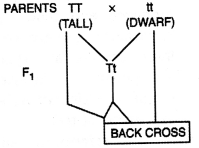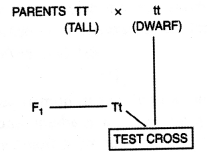Here we are providing Class 12 Biology Important Extra Questions and Answers Chapter 5 Principles of Inheritance and Variation. Important Questions for Class 12 Biology are the best resource for students which helps in Class 12 board exams.
Class 12 Biology Chapter 5 Important Extra Questions Principles of Inheritance and Variation
Principles of Inheritance and Variation Important Extra Questions Very Short Answer Type
Question 1.
Name one trait that does not blend.
Answer:
Sex does not blend.
Question 2.
Give one example of a genetic trait for each of the following in humans:
1. Lethality
Answer:
Lethality: Homozygous sickle cell anaemia.
2. Multiple allelism.
Answer:
Example of Multiple allelism: ABO blood groups.
Question 3.
What for symbols AA and Aa stand?
Answer:
- AA: Homozygous dominant,
- Aa: Heterozygous dominant.
Question 4.
Name the plant that shows incomplete dominance in respect to the colour of its flower.
Answer:
Mirabilis jalapa.
Question 5.
Write the genotypes of a man with blood group A.
Answer:
lAlA, lAl0
Question 6.
What is Mendel’s monohybrid ratio for phenotypes?
Answer:
3:1.
Question 7.
Write down Mendel’s dihybrid ratio for phenotypes.
Answer:
9: 3: 3: 1.
Question 8.
Who were the discoverers of Mendelism?
Answer:
Hugo de Vries, Karl Correns, Erich von Tschermak were the rediscoverers of Mendelism.
Question 9.
What are the real determinants of what an organism will become?
Answer:
The complex interaction between genes and their environment really determine what an organism will become.
Question 10.
Name the disorder in humans with the following karyotype:
(a) 22 pairs of autosomes + XO
(b) 22 pairs of autosomes + 21 st chromosome + XY (CBSE Outside Delhi 2019)
Answer:
| Karyotype | Name of Disorder |
| (a) 22 pairs of autosomes + XO | Turner’s syndrome |
| (b) 22 pairs of autosomes + 21st chromosome + XY | Down’s syndrome (MongoLism inmate) |
Question 11.
What wilt is the genetic makeup of an organism which suffers from sickle cell anaemia?
Answer:
Homozygous (HbS HbS).
Question 12.
Name the type of cross that would help to find the genotype of a pea plant bearing violet flowers. (CBSE Delhi 2017)
Answer:
Test cross.
Question 13.
What term is used for the two chromatids resulting from the interchange of segments during crossing over?
Answer:
Recombinants (cross overs).
Question 14.
Write one example of each of organisms exhibiting
(i) male heterogamety
Answer:
Male heterogamety: Drosophila and humans
(ii) female heterogamety. (CBS£ Delhi 2019 C)
Answer:
Female heterogamety: Birds and some reptiles
Question 15.
A geneticist is interested in study variations and pattern in living being preferred to choose an organism with the short life cycle. Provide a reason. (CBSE Delhi 2015)
Answer:
An organism with a shorter life cycle is helpful in rapid study and analysis of hereditary pattern in many generations, e.g. Drosophila, Neurospora.
Question 16.
Give an example of a human disorder that is caused due to a single gene mutation. (CBSE Delhi 2016)
Answer:
Phenylketonuria.
Question 17.
Write the sex of human having XXY chromosomes with 22 pairs of autosomes. Name the disorder this human suffers from. (CBSE Delhi 2016)
Answer:
The human is male (as Y chromosome is present). He is suffering from Klinefelter’s syndrome
Principles of Inheritance and Variation Important Extra Questions Short Answer Type
Question 1.
State the Mendelian principle which can be derived from a dihybrid cross and not from monohybrid cross.
Or
State Mendel’s Law of Independent Assortment. CBSE Sample Paper 2018-19)
Answer:
From the dihybrid cross, the law of independent assortment can be derived which states that, when two pairs of traits are combined in a hybrid, segregation of one pair of characters is independent of the other pair of characters.
Question 2.
In a cross between two tall pea plants, some of the offsprings produced pure dwarf. Show with the help of Punnett square how this is possible. (CBSE (Delhi) 2013)
Answer:
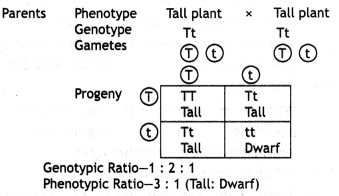
Question 3.
What is a dihybrid cross?
Answer:
Dihybrid cross. A cross in which two characters are taken into consideration during experimentation, such a cross is called dihybrid cross. A cross between a pea plant with yellow smooth seeds and a pea plant with green, wrinkled seeds is a dihybrid cross.
From the dihybrid cross, it can be derived that each gene is assorted independently of the other during its passage from one generation to the other or Law of independent assortment.
Question 4.
In order to obtain the E, generation, Mendel pollinated a pure breeding tall plant with a pure breeding dwarf plant. But forgetting the F2 generation, he simply self-pollinated the tall F1 plants. Why?
Answer:
- He made crosses to study the pattern of inheritance of a few characters over generations.
- Initially, he made pure lines.
- To create a heterozygote or hybrid, he had to cross two different plants (pure lines).
- To study the inheritance pattern; it is enough if the hybrids are self – pollinated, thus the segregation of factors can be studied.
Question 5.
A cross between a red flower-bearing plant and a white flower-bearing plant of Antirrhinum majus produced all plants having pink flowers. Work out across, to explain how is this possible? (CBSE Outside Delhi 2013)
Answer:
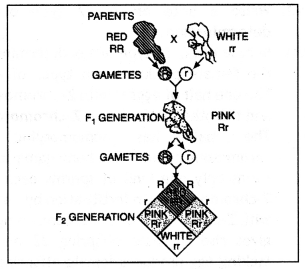
Question 6.
Differentiate gene and allele.
Answer:
Difference between gene and allele:
Allele (allelomorphs) refers to the alternate form of a gene pair present on the same loci in the homologous chromosome, whereas gene is the smallest unit of an organism capable of transmitting genetic information and expressing the same.
Question 7.
In Snapdragon, a cross between true-breeding red-flowered (RR) plants and true-breeding white-flowered (RR) plants showed a progeny of plants with all pink flowers.
(i) The appearance of pink flowers is not known as blending. Why?
Answer:
It is not a case of blending. In this case, R gene was not completely dominant over r gene and this made genotype Rr to distinguish as pink.
(ii) What is this phenomenon known as? (CBSE 2014)
Answer:
Incomplete dominance.
Question 8.
With the help of one example, explain the phenomena of co-dominance and multiple allelism in the human population. (CBSE 2014)
Answer:
In the case of co-dominance, two alleles for a trait are equally expressed.
Example: ABO blood groups are controlled by the gene I. The gene I have three alleles lA, lB and lO. These alleles determine the type of sugar on the RBC surface. Alleles lA and lB are co-dominant and express the AB blood group.
Since there are three different alleles and express themselves on the basis of dominance recessiveness and co-dominance, it is a case of multiple allelism.
Question 9.
The child has a blood group of O. If the father has blood group A and mother has blood group B, work out the genotypes of the parents and the possible genotypes of the other offsprings. (CBSE Outside Delhi, 2015, 2019)
Answer:
- Genotypes. Man (lA lO) Mother lB lO and child lO lO.
- The blood group of the future offspring. A type, B type, 0 types and AB type. It is based on the following cross:

Inheritance of blood groups A, B, O, AB
Question 10.
Give examples of sex-linked inheritance in Drosophila. During his studies on genes in Drosophila that were sex-linked T.H. Morgan found F2 population phenotypic ratios deviated from expected 9: 3: 3: 1. Explain the conclusion he arrived at. (CBSE 2010)
Answer:
Examples of sex-linked inheritance in Drosophila (Morgan’s conclusion).
- Genes for white eye colour is located in the X-chromosome and Y-chromosome is empty carrying no normal allele for white eye colour.
- The white-eyed female possesses a gene for white eye colour (W) on both of its X-chromosomes.
- The white-eyed males receive X-chromosome with (W) gene from mother and (Y) from father with no gene.
- The daughter receives one X-chromosome with (W) gene from mother and one X-chromosome with dominant (W+).
Question 11.
Briefly explain XX-XO (a type of sex determination).
Answer:
In the case of roundworms, true bugs, grasshoppers and cockroaches the females have two sex chromosomes XX, whereas the males have only one X-chromosome. The male has no second chromosome thus designated as XO. The sex ratio of 1: 1 is produced as shown in the figure below.

XX-XO determination of sex in the cockroach.
Question 12.
Explain the mechanism of ‘sex determination’ in birds. How does it differ from that of human beings? (CBSE Delhi 2018)
Answer:
Sex determination is of ZW-ZZ type in birds.
In this type, the males are homogametic and have ZZ sex chromosomes, and females are heterogametic with ZW pair of sex chromosomes.
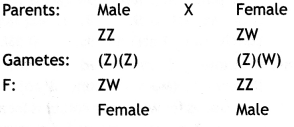
In human beings, the chromosomal mechanism of sex determination is of XX- XY type. The human male is heterogametic and has XY sex chromosomes, whereas the human female is homogametic with XX sex chromosomes.
Question 13.
Write a note on ZO-ZZ type of sex determination.
Answer:
In case of ZO-ZZ type of sex determination the female produces two types of eggs. The one-half of eggs is with Z-chromosome and the other half without Z-chromosome. The male has homomorphic sex chromosomes and is homogametic. It forms only one kind of sperms each with Z-chromosome. On fertilisation by a sperm with Z-chromosome, the Z-containing egg gives rise to male offspring ZZ and Z- lacking egg produces female offspring ZO. Such type of sex determination is found in the case of butterflies and moths.
Question 14.
Give an example of an autosomal recessive trait in humans. Explain its pattern of inheritance with the help of a cross. (CBSE Delhi 2016)
Answer:
Autosomal recessive trait. Sickle-cell anaemia is caused by autosomal recessive trait. The disease is controlled by a single pair of alleles HbA and HbS. Only the homozygous individuals for HbsHbs show the disease. The heterozygous individuals are carriers (HbA Hbs)
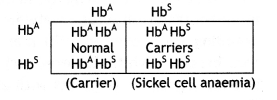
Question 15.
How would you find the genotype of a tall pea plant bearing white flowers? Explain with the help of a cross. Name the types of the cross you would use. (CBSE Delhi 201i 5)
Answer:
In order to find the genotype of a given plant, one has to breed it with plenty of oic recessive individual. It is called test CRC is. Tall and white plant TTww or Ttww / is crossed with dwarf white plant ttww TTww x ttww

(All tall white plants indicate that the genotype is TTww)
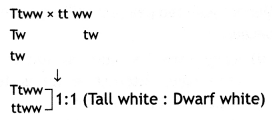
This ratio indicates that the genotype is Ttww
Depending on the resuLt we can determine the genotype of the flower.
Question 16.
How is polygenic inheritance different from pleiotropy? Give one example of each.
Answer:
| polygenic inheritance | pleiotropy |
| It is a type of inheritance in which. a single dominant gene contributes a part of the trait. Thus dominant alleles have a cumulative effect. | It is a condition in which a single gene influence more than one trait. |
| Example: 1. Cob length in maize 2. Skin colour in human |
Example: 1. In Drosophila, white eye mutant causes depigmentation in many parts of the body. 2. Sickle cell anaemia |
Question 17.
Why is it not possible to study the pattern of inheritance of traits in human beings, the same way as it is done in pea plant? Name the alternate method employed for such an analysis of human traits.
Answer:
- Control cross cannot be performed in human as in other organisms.
- The generation time is long. Pedigree analysis is the alternative method to study the inheritance of human traits in several generations.
Question 18.
A man with blood group A married a woman with a B group. They have a son with AB blood group and a daughter with blood group 0. Work out the cross and show the possibility of such inheritance. (CBSE Delhi and Outside Delhi 2008)
Answer:
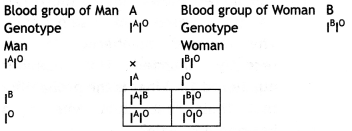
Blood groups of progeny A, B, AB and O.
Question 19.
A haemophilic father can never pass the gene for haemophilia to his son. Explain. (CBSE Delhi 2016)
Answer:
Haemophilia is a sex-linked recessive disorder where X chromosome carries the defective haemophilic gene and Y chromosome is healthy. And son inherits only the Y chromosome from his father which is not carrying the gene for haemophilia. Therefore, the haemophilic father can never pass haemophilia to his son.
Principles of Inheritance and Variation Important Extra Questions Long Answer Type
Question 1.
Study the given pedigree chart and answer the questions that follow:
1. Is the trait recessive or dominant?
Answer:
Dominant.
2. Is the trait sex-linked or autosomal?
Answer:
Autosomal.
3. Give the genotypes of the parents shown in generation I and their third child is shown in generation II and the first grandchild shown in generation III. (CBSE Sample Paper 2018-19)

Answer:
The genotype of parents in generation I – Female: aa and Male: Aa
The genotype of a third child in generation II-Aa Genotype of the first grandchild in generation III – Aa
Question 2.
Haemophilia is a sex-linked recessive disorder of humans. The pedigree chart given below shows the inheritance of Haemophilia in one family.
Study the pattern of inheritance and answer the questions given.
1.Give all the possible genotypes of the members 4, 5 and 6 in the pedigree chart.
2. A blood test shows that the individual 14 is a carrier of haemophilia. The member numbered 15 has recently married the member numbered 14. What is the probability that their first child will be a haemophilic male?
(CBSE 2009, CBSE Sample Paper 2018-19)
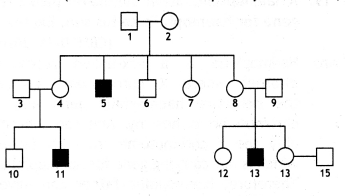
Answer:
- Genotypes of member 4 – XX or XXh Genotypes of member 5 – XhY Genotypes of member 6 – XY
- The probability of first child to be a haemophilic male is 50%.
Question 3.
Mention the advantages of selecting a pea plant for the experiment by Mendel.
Answer:
Advantages of selecting pea plant as experimental material:
Mendel selected pea plant (Pisum sativum) because:
- Many varieties were available with observable alternative forms for a trait or a characteristic.
- Peas normally self-pollinate; as their corolla completely encloses the reproductive organs until pollination is complete.
- It was easily available.
- It has pure lines for experimental purpose, i.e. they always breed true.
- It has contrasting characters. The traits were seed colour, pod colour, pod shape, flower shape, the position of flower, seed shape and plant height.
- Its life cycle was short and produced a large number of offsprings.
- The plant can be grown easily and does not require care except at the time of pollination.
Question 4.
Differentiate between the following:
(i) Dominance and recessiveness
Answer:
Differences between dominance and recessiveness:
| Dominance | Recessiveness |
| (1) Dominant gene or factor is able to express itself even in the presence of its recessive allele. | (1) Recessive gene or factor is unable to express itself in the presence of dominant allele. |
| (2) It expresses itself because it forms complete polypeptide or enzyme for expressing its effect. | (2) The recessive gene forms an incomplete or defective polypeptide or enzyme thus fails to express its effect. |
(ii) Homozygous and heterozygous
Answer:
Differences between homozygous individual and a heterozygous individual:
| homozygous individual | heterozygous individual |
| (1) In a homozygous individual (homo-zygote) the two genes for a particular character are identical (TT) or (tt). | (1) The heterozygous individual (hetero zygote) possesses contrasting genes of a pair çrt). |
| (2) They form identical gametes for a particular character. | (2) They form dissimilar gametes for a particular character. |
| (3) They breed true for a specific trait. | (3) They do not breed true. |
Question 5.
Explain the law of dominance using a monohybrid cross.
Answer:
Law of Dominance. According to this law, when two factors of a character are unlike, one of them will manifest in the body and is called dominant while the other remains hidden and is termed recessive factor.
The law can be well explained by the monohybrid cross by studying the following crosses:
(i) Pure tall = TT, Hybrid tall = Tt
Gametes of TT parent = \(\frac { 1 }{ 2 }\)T + \(\frac { 1 }{ 2 }\)T
Gametes of Tt parent = \(\frac { 1 }{ 2 }\)T + \(\frac { 1 }{ 2 }\)t
The 50% are pure tall and 50% hybrid tall. Then pure tall plants will produce 100% tall in F2 generation and hybrid plants will produce in the ratio of 1: 2: 1 in the F2 generation.
(ii) When the cross is made between pure tall and pure dwarf, we get results as follows (Fig.).
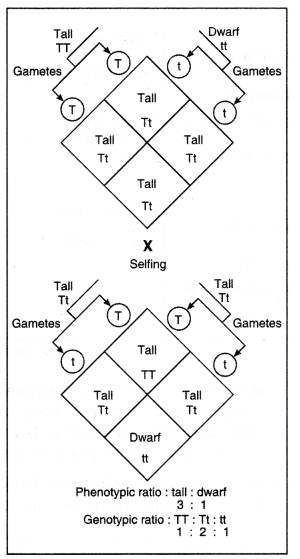
A Punnett square used to understand a typical monohybrid cross conducted by Mendes between true-breeding tall plants and true-breeding dwarf plants
Question 6.
Define and design a test cross.
Answer:
Test Cross: It is a cross between an organism of an unknown genotype and a homozygous recessive organism.
Results of a Test Cross: If the test cross yields offspring of which 50% show the dominant character and 50% show the recessive character, i.e. F1 ratio is 1: 1, the individual under test is heterozygous (see fig.). This is so because the individual showing the recessive trait (say white coat colour in the guinea pig, dwarf size in pea plant) must have received one recessive allele (b in a guinea pig, t in pea plant) from each parent.
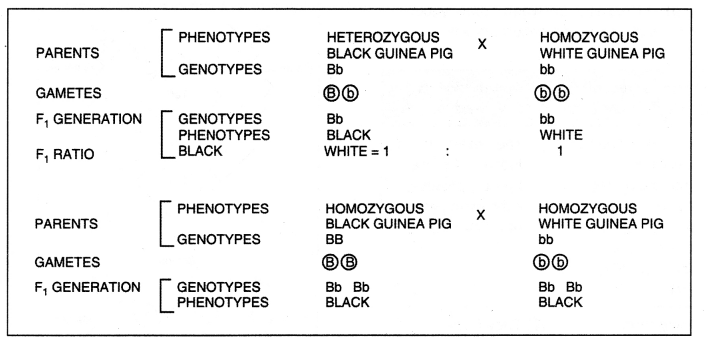
Genetics of a test cross
If all the offspring of the test cross show the dominant trait, the individual being tested is homozygous dominant with genotype BB for a guinea pig and TT for pea plant (fig.).
Question 7.
When a cross is made between a tall plant with yellow seeds (TtYy) and tall plant with green seeds (Ttyy), what proportions of phenotype In the offspring could be expected to be
(i) tall and green
(ii) dwarf and green?
Answer:
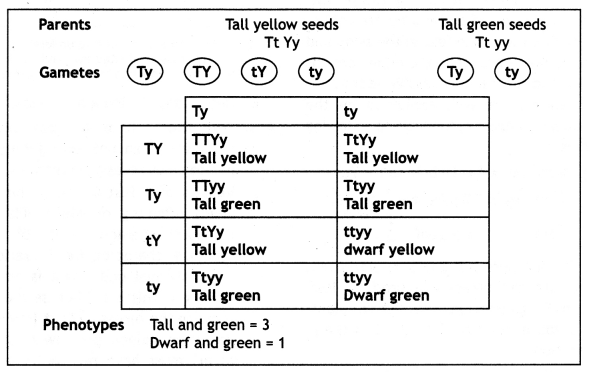
Cross between a tall plant with yellow seeds
Question 8.
Differentiate back cross and test cross.
Answer:
Differences between the back cross and test cross:
| Back cross | Test cross |
| 1. It is the hybridisation process between F1 progeny and one of its parents.
|
1. It represents the hybridisation between F1 progeny with the homozygous recessive parent.
|
| 2. The ratio of F2 progeny maybe 1: 1. | 2. The ratio of F2 progeny is 1:1. |
| 3. It is used to develop a good hybrid particularly through recurring back cross. | 3. It is used to testify the genotype of the F1 progeny. |
Question 9.
Differentiate incomplete dominance and codominance.
or
Explain the following terms with an example:
(i) Codominance
(ii) Incomplete dominance (CBSE Outside Delhi 2008; Delhi 2011, 2019)
Answer:
Differences between incomplete dominance and codominance:
| Incomplete Dominance | Codominance |
| (1) Effect of one of the two alleles is more prominent. | (1) The effect of both the alleles is equally prominent. |
| (2) It produces a fine mixture of the expression of two alleles. | (2) There is no mixing of the effect of the two alleles. |
| (3) The effect in hybrid is intermediate of the expression of the two alleles, e.g. pink coloured snapdragon obtained as a result of cross-pollination between red and white snapdragon flowers. | (3) Both the alleles produce their effect independently, e.g. IA and lB, HbS and HbA. |
Question 10.
(i) Why is the human ABO blood group gene considered a good example of multiple alleles?
Answer:
A B O blood groups are controlled by a single gene: (I) The plasma membrane of the red blood cells has sugar polymers that protrude from its surface and is controlled by the gene. The gene (I) has three alleles lA, lBand lO. Presence of more than two types of alleles at the same locus governing the same character is called multiple alleles.
(ii) Work out across up to F2 generation only, between a mother with blood group A (Homozygous) and the father with blood group B (Homozygous). Explain the pattern of inheritance exhibited. (CBSE (Delhi) 2013)
Or
Describe the mechanism of a pattern of inheritance of ABO blood groups in human. (CBSE 2011)
Answer:
Patterns of inheritance of the ABO blood group.
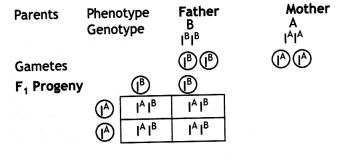
F1 generation. All with blood group AB. It is a case of co-dominance.
Question 11.
(i) What is polygenic inheritance? Explain with the help of a suitable example, (ii) How are pleiotropy and Mendelian pattern of inheritance different from the polygenic pattern of inheritance? (CBSE Outside Delhi 2016)
Or
Certain phenotypes in the human population are spread over a gradient and reflect the contribution of more than two genes. Mention the term used for the type of inheritance. Describe it with the help of an example in the human population. (CBSE Sample Paper 2019-20)
Answer:
(i) Polygenic inheritance. It is a type of inheritance controlled by three or more genes in which the dominant alleles have a cumulative effect. Each dominant allele expresses a part or unit of a trait. It is also called quantitative inheritance or multiple factor inheritance. The genes involved in such kind of inheritance are termed polygenes.
Examples:
- Kernel colour in wheat
- Cob length in maize
- Skin colour in human
- Human intelligence Human Skin Colour. It is caused by the pigment melanin.
The quantity of melanin is due to three pairs of polygenes (A, B and C). The genotype of black will be (AA BB CC) and white will have (aa bb cc). Marriage between two such persons will show variations. In progeny (Aa Bb CC) there will be 7 types of phenotypes i.e. very dark, 6 dark, 15 fairly dark, 20 intermediates, 15 family light, 6 light and have very light.
(ii) How are pleiotropy and Mendelian pattern of inheritance different from the polygenic pattern of inheritance? (CBSE Outside Delhi 2016)
Answer:
1. Pleiotropy and Mendelian pattern of inheritance: In the case of pleiotropy one gene has an effect on two on more traits. One effect is more evident in the case of one trait (major effect) and less evident in the case of others (secondary effect). The mendelian pattern of inheritance is monogenic.
2. In pleiotropism and monogenic inheritance no intermediates are produced and show discontinuous variations in the expression of a trait. Intermediates are quite common in polygenic inheritance and produce continuous variations in the expression of a trait.
Question 12.
(i) Write the scientific name of the organism Thomas Hunt Morgan and his colleagues worked with for their experiments. Explain the correlation between linkage and recombination with respect to genes as studied by them.
Answer:
Thomas Hunt Morgan and his colleagues worked with Drosophila melanogaster. They carried out several dihybrid crosses in Drosophila to study gens that were sex-linked.
Morgan and his group knew that the genes were located on the X chromosome and noticed that when the two genes in a dihybrid cross were situated on the same chromosome, the proportion of parental gene combinations were much higher than the non-parental type.
Morgan attributed this due to the physical association or linkage of th< two genes. He coined the term links to describe this physical associate of genes on a chromosome and t/ term recombination to describe t generation of non-parental age combination. Morgan and his also found that even when genes w grouped on the same chromos or some genes were very tightly linked, they showed very low recombine while others were loosely linked.
(ii) How did Sturtevant explain gene mapping while working with Morgan? (CBSE Delhi 2018)
Answer:
Alfred Sturtevant was Morgan’s student. He used the frequency of recombination between gene pairs on the same chromosome as a measure of the distance between genes and ‘mapped’ their position on the chromosome. Today genetic mappings are extensively used as a starting point in the sequencing of the whole genomes.
Question 13.
What is recombination? Discuss the applications of recombination from the point of view of genetic engineering.
Answer:
Recombination refers to the generation of a new combination of genes which is different from the parental types. It is produced due to crossing over that occurs during meiosis prior to gamete formation.
Applications of recombination:
- It is a means of introducing new combinations of genes and hence new traits.
- It increases variability which is useful for natural selection under changing environment.
- It is used for preparing linkage chromosome maps.
- It has proved that genes lie in a linear fashion in the chromosome.
- Breeders have to select small or large population for obtaining the required cross-overs. For obtaining cross-overs between closely linked genes, a very large population is required.
- Useful recombinations produced by crossing over are picked up by breeders to produce useful new varieties of crop plants and animals. Green revolution and white revolution were implemented using the selective recombination technique.
Question 14.
How is sex determined? (CBSE Delhi 2015)
Answer:
Determination of the sex of the child. Sex chromosomes determine sex in human beings. In males, there are 44+XY chromosomes, whereas in female there are 44+XX chromosomes. Here X and Y chromosomes determine sex in human beings.
Two types of gametes are formed in male, one type is having 50% X-chromosome, whereas another type is having Y-chromosome. In a female, gametes are of one type and contain X-chromosome. Thus females are homogametic and males are heterogametic. If male gamete having Y-chromosome (endosperm) undergoes fusion with female gamete having X-chromosome, the zygote will have XY chromosome and this gives rise to a male child.
If male gamete having X-chromosome (gymnosperm) undergoes fusion with female gamete having X-chromosome, the zygote will be having XX-chromosome and this gives rise to the female child.

Genetics of sex in human beings. The letter A represents autosomes.
Question 15.
Both haemophilia and thalassemia are blood-related disorders in human. Write their causes and the difference between the two. Name the category of genetic disorder they both come under. (CBSE Delhi 2017)
Answer:
Both haemophilia and thalassemia are Mendelian disorders:
- Haemophilia is a sex-linked recessive disorder. The gene for haemophilia is located on X-chromosome. The gene passes from a carrier female to her son.
- Thalassemia is an autosomal-linked recessive disease.
- It occurs due to either mutation or deletion resulting in the reduced rate of synthesis of one of the globin chains of haemoglobin.
- Difference between Haemophilia and Thalassemia. In haemophilia, clotting is affected, i.e. there can be a non-stop bleeding even after a minor cut.
- In Thalassemia anaemia is the characteristic of this disease. It is caused by faulty haemoglobin synthesis.
Question 16.
Differentiate male and female heterogamety. (CBSE Delhi 2015, 2019 C)
Answer:
Differences between male and female heterogamety:
| Male heterogamety | female heterogamety |
| (1) Mate heterogamety refers to the phenomenon, where mates produce two (more than one) types of sperms. | (1) Female heterogamety refers to the phenomenon, where females produce two (more than one) types of ova. |
| (2) Sex of the individual is determined by the type of sperm fertilising the ovum. | (2) Sex of the individual is determined by the type of ovum that is fertilisers. |
| (3) XX female XY male | (3) ZZ male and ZW female. |
Question 17.
Why Drosophila has been used extensively for genetical studies? (CBSE 2014, 2019 C)
Answer:
Advantages of using Drosophila as genetic material:
Drosophila is a very useful organism for genetical experiments because:
- A very large number of offsprings are produced after each mating.
- It can be cultured in large number in laboratory and animals can be easily examined under a hand lens.
- Its life cycle is very short and is completed in 10-12 days. A new generation can be obtained every two weeks.
- It has four pairs of chromosomes all different in size and easily distinguishable.
- They produce numerous variants.
- It has heteromorphic (XY) chromosomes in the male.
- Female Drosophila flies can be easily differentiated from the males by the large body size and presence of ovipositor in the abdomen.
Question 18.
Mendel published his work on the inheritance of characters in 1865, but it remained unrecognised till 1900. Give three reasons for the delay in accepting his work. (CBSE Delhi 2014)
Answer:
Mendel’s work published as “Experiments on plant hybridisation” remained unnoticed and unappreciated for some 34 years due to:
- Limited circulation of the “Proceedings of Brunn Natural Science Society” in which it was published.
- He could not convince himself about his conclusions being universal since Mendel failed to reproduce the results on Hawkweed (Hieracium) undertaken on the suggestion of Naegeli. It was due to non-availability of pure lines.
- Absence of aggressiveness in his personality.
- The scientific world was being rocket^ at that time by Darwin’s theory c}f Natural Selection.
Question 19.
Compare in any three ways the chromosomal theory of inheritance as proposed by Sutton and Boveri with that of experimental results on pea pie int presented by Mendel. (CBSE Delhi 2019)
Answer:
| Sutton and Boveri | Mendel |
| (1) Chromosomes occur in pairs. | (1) Factors occur in pairs. |
| (2) Chromosomes segregate during gamete formation such that only one of each pair is transmitted to a gamete. | (2) Factors segregate during gamete formation stage and only one of each pair is transmitted to a gamete. |
| (3) Independent pairs of chromosomes segregate independently of each other. | (3) One pair of factors segregate independently of another pair. |
Question 20.
(a) Explain linkage and recombination as put forth by T.H. Morgan based on his observations with Drosophila melanogaster crossing experiment.
(b) Write the basis on which Alfred Sturtevant explained gene mapping. (CBSE Delhi 2019)
Answer:
(a) Linkage and recombination:
- Morgan is called the father of experimental genetics.
- Morgan used Drosophila for experiments of genetics.
- Linkage: It is the phenomenon of certain genes staying together during inheritance through several generations without any change or separation of these being present on the same chromosome. The two genes do not segregate independently of each other. So, F2 generation deviates significantly from 9:3:3:1.
- Recombination: Loosely linked genes show a higher frequency of recombinant frequency which is around 37.2%. Tightly linked genes tend to show fewer recombinant frequency which is around 1.3%.
(b) Morgan’s student Alfred Sturtevant used the frequency of recombination between gene pairs on the same chromosome as a measure of the distance between genes and mapped their position on a chromosome.
Question 21.
ExplaIn how a test cross can be conducted to distinguish between a homozygous and heterozygous dominant genotype. What is the test cross? How can it decipher heterozygosity of a plant? (CBSE Delhi 2016)
Or
How will you find out whether a given plant is homozygous dominant? (CBSE 2008)
Or
You are given a tall pea plant and asked to find its genotype. How will you find it? (CBSE Outside Delhi 2019)
Answer:
Test Cross. When an individual is crossed to recessive parent it is called a test cross. The results can be easily analysed. If you follow the monohybrid cross where the FT is test crossed, a ratio of 1:1 will be obtained. On the same basis, you can work out that in a dihybrid case, the test cross ratio will be 1:1:1:1. Test cross can also be used for another purpose.
You must have understood by now that the homo and heterozygous genotypes for a dominant trait cannot be differentiated because they show the same phenotype. If we put them through a test cross, you will see that all homozygous dominant combinations will breed true but heterozygous genotypes will follow the segregation.
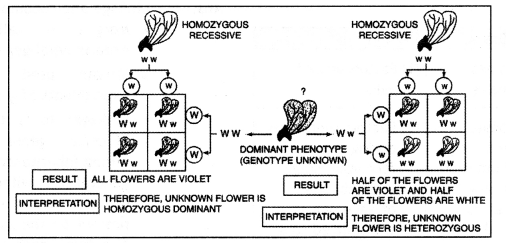
A test cross can be conducted to differentiate between a homozygous and heterozygous dominant genotype.
Question 22.
Explain the law of independent assortment with a dihybrid cross. (CBSE Outside Delhi, 2013, 2014)
Answer:
Law of independent assortment: According to this law, the factors of different pairs of contrasting characters do not influence each other. They are independent of one another in their assortment to form a new combination during gamete formation. Dihybrid cross. A cross in which two characters are taken into consideration during experimentation, such a cross is called dihybrid cross.
A cross between a pea plant with yellow smooth and a pea plant with green, wrinkled seeds is considered. Explanation. When a cross is made between pea plant having yellow smooth seeds (YYSS) and a pea plant with green wrinkled seeds (yyss). At the time of cross-pollination, yellow smooth (YYSS) produces gametes with genes (YS) and green wrinkled will produce gametes with gene (ys). Gametes unite at random. The seeds obtained when placed in the soil will grow to form plants and produce seeds which are yellow smooth (YySs) because yellow and smooth characters are dominant over green and wrinkled. These are called plants of F1 generation.
When plants of F1 generation are allowed to self-pollinate gametes formed YS, Ys, yS and ys by meiosis, they unite at random forming seeds. The plants thus obtained are called F2 generation. They are Yellow smooth (YYSS, YySS, YySs, YYSs); yellow wrinkled (YYss, Yyss), green smooth (yySS, yySs) and green wrinkled (yyss) in the ratio of 9: 3: 3: 1. The result of a dihybrid cross can be shown in Fig. on the chequerboard.

Result of a dihybrid cross.
From the above dihybrid cross, it can be derived that each gene is assorted independently of the other during its passage from one generation to the other or law of independent assortment is justified.
Question 23.
In four o’clock plants, red colour (R) is incompletely dominant over white (r), the heterozygous having pink colour. What will be the offspring in a cross between a red flower and a pink flower? (CBSE Outside Delhi, 2013)
Answer:
- In the monohybrid cross, red is incompletely dominant over white.
- Red flowered plants have genotype RR and white-flowered plants have genotype rr.
- Pink flowers have a genotype Rr.
- Red flowering plants will form gametes with R genes and pink flowers will produce two types of gametes with R gene and r gene.
- Arrangement of gametes in chequerboard.
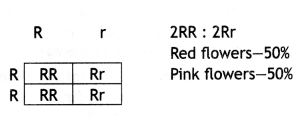
Question 24.
Explain the pattern of inheritance of haemophilia in humans. Why is the possibility of a human female becoming a haemophilic extremely rare? Explain. (CBSE Delhi, 2008; Outside Delhi 2011)
Or
Why is human female rarely haemophilic? Explain how do haemophilic patients suffer? (CBSE Outside Delhi 2013)
Answer:
A pattern of inheritance of haemophilia:
- It is the sex-linked recessive trait which is known as bleeder’s disease because the exposed blood does not readily clot due to deficiency of plasma thromboplastin (haemophilia B/ Christmas disease) or Antihaemophilia globulin (haemophilia A)
- The defect has been inherited in the family of British Crown through Queen Victoria.
- In females, haemophilia appears when both the sex chromosomes carry its recessive gene, Xh Xh. Such females die before birth.
- A woman having a single allele of the trait appears normal but is a carrier of the disease XXh
- For sex-linked genes, human males are hemizygous. Therefore, Xh Y is haemophilic.
- Marriage between haemophilic male and carrier female produces haemophilic sons (XhY, 50%), normal sons (XY, 50%), carrier daughters (XXh, 50%) and haemophilic daughters (XhXh, 50%, die before birth).
- Haemophilic man (XhY) and normal woman (XX) produce carrier girls (XXh) and normal boys (XY).
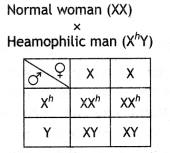
- Marriage between carrier woman and normal man produce 50% carrier girls (XXh), 50% normal girls (XX), 50% normal boys (XY) and 50% haemophilic boys (XhY).
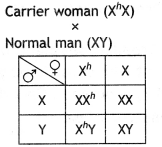
Sons- 50% normaL 50% heamophitic
Daughters- 50% normaL 50% camer - The possibility of a female becoming haemophilic is very rare because the mother of such a female has to be at least a carrier and father should be haemophilic.
Question 25.
A colourblind child is born to a normal couple. Work out a cross to show how is it possible. Mention the sex of this child. (CBSE Delhi 2014, 2016)
Answer:
(a) Colourblindness is an X-linked recessive disease

So, the sex of the child is male.
Question 26.
1. How does a chromosomal disorder differ from a Mendelian disorder?
2. Name any two chromosomal aberra¬tion associated disorders.
3. List the characteristics of the disorders mentioned above that help in their diagnosis. (CBSE 2010)
Or
How does gain or loss of chromosome(s) take place in humans? Describe one example each of chromosomal disorder along with the symptoms involving an autosome and a sex chromosome. (CBSE Sample Paper 2019-20)
Answer:
1. Mendelian disorders are mainly determined by alteration or mutation in a single gene. These disorders are transmitted to the offspring on the basis of Mendelian inheritance, e.g. haemophilia, sickle cell anaemia. Chromosomal disorders are caused due to absence or excess or abnormal arrangement of one or more chromosomes. They are caused due to failure of segregation of chromatids during cell division or due to polyploidy. e.g. Down’s syndrome, Klinefelter syndrome.
2. Chromosomal aberration associated disorders.
(a) Down’s syndrome
(b) Klinefelter syndrome.
3. (a) Down’s syndrome. It is caused due to an additional copy of chromosome number 21 (Trisomy).
Symptoms: Short statured body, small rounded head, furrowed tongue, partially open mouth.
(b) Klinefelter syndrome. It is caused due to an additional copy of X-chromosomes (47 chromosome XXY).
Symptoms. Overall masculine development but the development of breast also occurs. These individuals are sterile.
Question 27.
A true-breeding pea plant, homozygous for inflated green pods (FFGG) is crossed with another pea plant with constricted yellow pods (ffgg). What would be the phenotype and genotype F1 and F2 genotype? Give the phenotype ratio of F2 generation. (CBSE Delhi 2008)
Answer:


Question 28.
A true-breeding pea plant homozygous for axial violet flowers (AAW) crossed with another pea plant with terminal white flowers (aaw).
(i) What would be phenotype and genotype of F1 and F2 generations
Answer:

(ii) Give the phenotype ratio of F2 generations. (CBSE Delhi. 2008)
Answer:

Question 29.
A child suffering from Thalassemia is born to a normal couple. But the mother is being blamed by the family for delivering a sick baby.
(i) What is Thalassemia?
Answer:
Thalassemia: It is an autosomal recessive blood disease that appears in children of two unaffected carriers, heterozygote parents. The defect occurs due to mutation or deletion of the genes controlling the formation of globin chain (commonly a and P) of haemoglobin. Imbalanced synthesis of globin chains of haemoglobin causes anaemia. Thalassemia is of three types a, p, and 8.
(ii) How would you counsel the family not to blame the mother for delivering a child suffering from this disease? Explain.
Answer:
I would explain to the people around that this disease can be caused due to the presence of a defective gene in both the parents or it may be caused due to certain changes with the genetic setup.
(iii) List the values your counselling can propagate in the families. (CBSE Delhi 2013)
Answer:
People had a good understanding and had to realize the situation. They become supportive and made joint efforts to help the patients.
Question 30.
In a dihybrid cross, white-eyed, yellow-bodied female Drosophila was crossed with red-eyed, brown-bodied male Drosophila. The cross produced 1.3 per cent recombinants and 98.7 progeny with parental type combinations in the F2 generation. Analyse the above observation and compare with the Mendelian dihybrid cross. (CBSE Sample Paper 2018-19)
Answer:
Morgan observed that the two genes did not segregate independently of each other and the F2 ratio deviated vary significantly from the 9:3:3:1 ratio.
He attributed this to physical association or linkage of two genes and coined the term linkage and the term recombination to describe the generation of non-parental gene combinations.
Morgan and his group found that even when the genes are grouped on the same chromosome, some genes are very tightly linked (show very low recombination) while others were loosely linked (showed higher recombination). in the Mendelian dihybrid cross, the phenotypes round, yellow; wrinkled, yellow; round, green and wrinkled, green appeared in the ratio 9:3:3:1.
Wrinkled, yellow and round, green is possible because the distance between two genes is more. Therefore, recombination of parental type is possible.
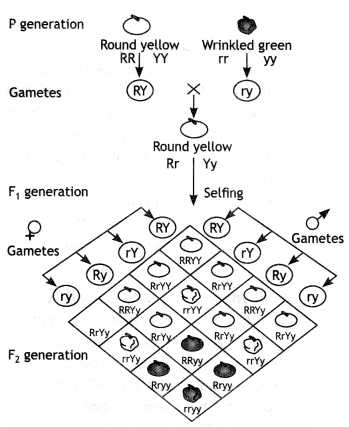
Question 31.
Aneuploidy of chromosomes in human beings results in certain disorders. Draw out the possibilities of the karyotype in common disorders of this kind in human beings and its consequences in individuals. (CBSE Sample Paper 2018-19)
Or
A doctor after conducting certain tests on a pregnant woman advised her to undergo M.T.P., as the foetus she was carrying showed trisomy of 21st chromosome.
(a) State the cause of trisomy of the 21 st chromosome.
Answer:
(a) Down’s syndrome, Turner’s syndrome, Klinefelter’s syndrome are common examples of Aneuploidy of chromosomes in human beings.
- Down’s syndrome results in the gain of the extra copy of chromosome 21- trisomy.
- Turner’s syndrome results due to the loss of an X chromosome in human females- XO monosomy.
- Klinefelter’s syndrome is caused due to the presence of an additional copy of X- chromosome resulting in XXY condition.
(b) Why was the pregnant woman advised to undergo M.T.P. and not to complete the full term of her pregnancy? Explain. (CBSE Delhi 2019 C)
Answer:
Down’s Syndrome: The affected individual is
- short statured with small round head furrowed tongue and partially open mouth
- Palm is broad with characteristic palm crease
- Physical, psychomotor, and mental development is retarded.
Klinefelter’s Syndrome: The affected individual is
- a male with development of breast, i.e. Gynecomastia
- Such individuals are sterile.
Turner’s Syndrome: The affected individual shows the following characters:
- Females are sterile as ovaries are rudimentary
- lack of other secondary sexual characters
Very Important Figures:
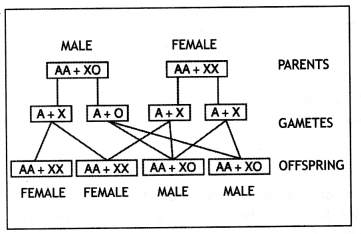
XX-XO determination of sex in the cockroach.
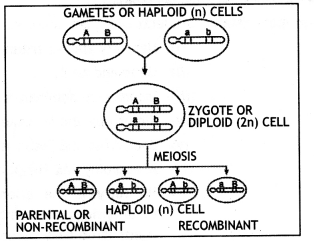
Formation of recombinant as well as non-recombinant (parental type) gametes.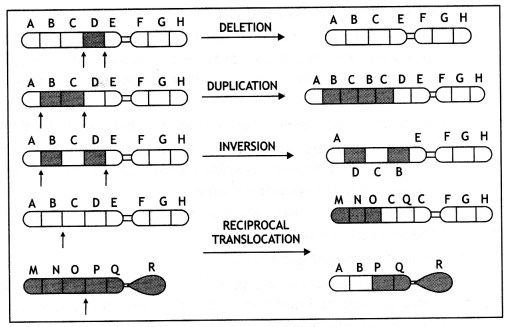
Forms of chromosomal mutations.
Answer:
| S. No Blood groups of parents | Blood groups possible in children | Blood groups not possible in children |
| 1. O × O | O | A, B, AB |
| 2. O × A | O, A | B, AB |
| 3. O × B | O, B | A, AB |
| 4. O × AB | A, B | O, AB |
| 5. A × A | O, A | B, AB |
| 6. A × B | O, A, B, AB | None |
| 7. A × AB | A, B, AB | O |
| 8. B × B | O, B | A, AB |
| 9. B × AB | A, B, AB | O |
| 10. AB × AB | A, B, AB | O |
